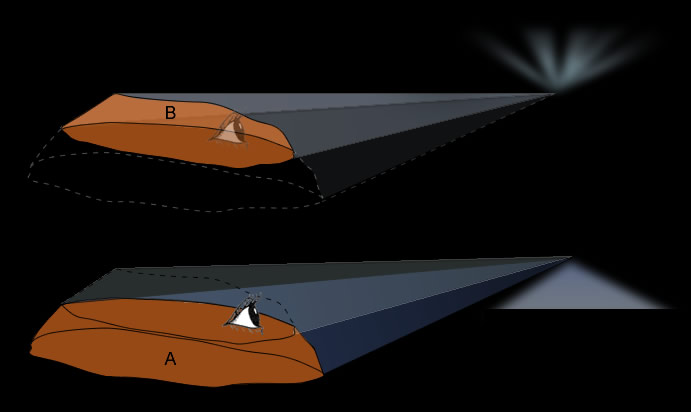 |
|
 |
 |
 |
| Shadow Spikes The dawn shadow of Mount Kilimanjaro imaged by Miguel de Olaso, Macgregor (site). Unusual dark spikes radiate upwards from Kilimanjaro's shadow. These are not (quite) anticrepuscular rays but are part of the shadow structure itself. To the left of the shadow and slightly below the horizon is the triangular mass of Mount Meru (4566m) some 70km distant to the west. ©Miguel de Olaso, Macgregor, shown with permission. |
 |
|
 |
 |
 |

| About - Submit | Optics Picture of the Day | Galleries | Previous | Next | Today |
| The key to the appearance of the upward shadow spikes is that Miguel took the photo 1145m below the 5895m high summit. Imagine Kilimanjaro sliced into two at the level where he was standing. Now take away the upper slice to leave only the lower one 'A'. All mountain shadows are three dimensional and are dark air. They appear to be triangular regardless of their profile because perspective makes their long almost parallel shadow tube recede to a point just as parallel railway tracks do. In the diagram the shadow of the lower mountain slice A is shown greatly foreshortened to get it on the page, in reality is very long and only slightly tapering. The shadow of the mountain slice below Miguel appears as the upward pointing triangular shape. In the actual image it is only faintly visible very close to the horizon. Now imagine that there is only the upper slice 'B' of the mountain above Miguel. The situation is the same except to the observer the mountain is upside-down. It casts an upside down triangular shadow into the sky. The closer you are to the summit the smaller and fainter is the triangle. It might also break into spikes as the summit is approached if the remaining mountain has an irregular profile or multiple summits. |
| Very close to the summit there was another shadow sight. The temperature was -16 Celsius. " Except for the blue sky, I think it´s the closest landscape that resembles Mars terrain on Earth. It´s dry, there is no water in liquid form even though there are huge water ice deposits standing nearby. " Around the shadow of Miguel's head and camera is a brighter area. This is an 'Opposition effect glow'. In that region no shadows are visible because they are hidden behind the rocks and soil undulations casting them. The area consequently appears brighter than the surrounding ones containing shadows. Retro-reflection by rock minerals and coherent backscattering also contribute to the brightness. Mars also shows an opposition effect. The absence of liquid water is important, when that is present a glow around shadows is produced by another effect - the heiligenschein. |
